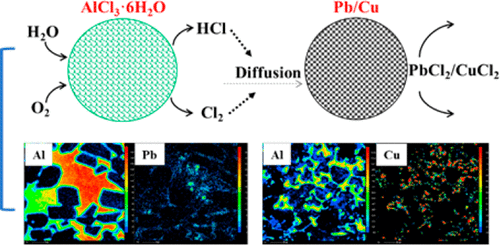当前位置:
X-MOL 学术
›
Energy Fuels
›
论文详情
Our official English website, www.x-mol.net, welcomes your
feedback! (Note: you will need to create a separate account there.)
Influence of Chlorine on the Fate of Pb and Cu during Clinkerization
Energy & Fuels ( IF 5.2 ) Pub Date : 2018-06-13 00:00:00 , DOI: 10.1021/acs.energyfuels.8b01111 Bin Zhang 1 , Anna Bogush 2 , Jiangxiong Wei 1, 3 , Weiting Xu 1 , Zhengxiang Zeng 1 , Tongsheng Zhang 1, 3 , Qijun Yu 1, 3 , Julia Stegemann 2
Energy & Fuels ( IF 5.2 ) Pub Date : 2018-06-13 00:00:00 , DOI: 10.1021/acs.energyfuels.8b01111 Bin Zhang 1 , Anna Bogush 2 , Jiangxiong Wei 1, 3 , Weiting Xu 1 , Zhengxiang Zeng 1 , Tongsheng Zhang 1, 3 , Qijun Yu 1, 3 , Julia Stegemann 2
Affiliation

|
The fate of heavy metals during clinkerization is of crucial significance to the utilization of solid waste as fuels and raw materials in cement kiln producing clinker. A ternary system of clinker–heavy metal–chlorine was developed that is more coincident with the condition of coprocessing of solid waste in cement kiln. The main goal of this study was to investigate the relationships among chlorine, volatilization and solidification of Cu/Pb, and the mineral phases of the clinker during clinkerization. The AlCl3·6H2O (chlorine source) and PbO/CuO were mixed with cement raw meal in appropriate ratios to produce coprocessed clinkers. The volatilization and solidification of Pb and Cu were investigated experimentally using a combination of atomic absorption spectrometry, electron probe microanalysis, scanning electron microscopy with energy-dispersive X-ray spectroscopy, optical microscope, and thermogravimetric and X-ray diffraction quantitative analyses. The volatilization ratios of Pb and Cu increased up to 46.18% and 34.04%, respectively, with increasing AlCl3·6H2O content up to 1.6% compared to the cement mixtures without AlCl3·6H2O addition (Pb and Cu volatilization ratios are 49.90% and 27.21%, respectively). Pb and Cu oxides can be transformed into Pb and Cu chlorides that are not stable and that have high vapor pressure. Pb and Cu are mainly concentrated in the interstitial phases of the clinker. The addition of AlCl3·6H2O led to the increase of the crystal size of alite and belite. X-ray diffraction quantitative analyses proved that the content of silicate phase increased with the corresponding content of interstitial phases decreasing during clinkerization with the addition of AlCl3·6H2O that decreased the ability of the clinker to solidify Pb and Cu in the produced clinkers. This research can help to promote understanding of the fate of heavy metals during the cement kiln coprocessing of solid wastes and can be meaningful for energy conservation and sustainable development.
中文翻译:

氯对熟化过程中铅和铜的命运的影响
熟料中重金属的命运对于水泥窑生产熟料中固体废物作为燃料和原材料的利用具有至关重要的意义。开发了一种熟料-重金属-氯三元系统,该系统与水泥窑中固体废物的共处理条件更加吻合。这项研究的主要目的是研究在熟化过程中氯,Cu / Pb的挥发和凝固与熟料的矿物相之间的关系。AlCl 3 ·6H 2将O(氯源)和PbO / CuO与水泥生粉按适当比例混合,以生产共处理的熟料。结合原子吸收光谱法,电子探针显微分析,扫描电子显微镜和能量色散X射线光谱法,光学显微镜以及热重和X射线衍射定量分析,对Pb和Cu的挥发和固化进行了实验研究。与不含AlCl 3 ·6H 2的水泥混合物相比,随着AlCl 3 ·6H 2 O含量的增加高达1.6%,Pb和Cu的挥发比分别增加了46.18%和34.04%。添加O(Pb和Cu的挥发比率分别为49.90%和27.21%)。Pb和Cu氧化物可以转化为不稳定的Pb和Cu氯化物,并且具有较高的蒸气压。Pb和Cu主要集中在熟料的间隙相中。AlCl 3 ·6H 2 O的添加导致了alite和belite晶体尺寸的增加。X射线衍射定量分析表明,熟化过程中添加AlCl 3 ·6H 2可以使硅酸盐相的含量增加,相应的间隙相的含量降低。O降低了熟料固化生产的熟料中铅和铜的能力。这项研究有助于增进对水泥窑固体废物共处理过程中重金属命运的了解,对于节约能源和实现可持续发展具有重要意义。
更新日期:2018-06-13
中文翻译:

氯对熟化过程中铅和铜的命运的影响
熟料中重金属的命运对于水泥窑生产熟料中固体废物作为燃料和原材料的利用具有至关重要的意义。开发了一种熟料-重金属-氯三元系统,该系统与水泥窑中固体废物的共处理条件更加吻合。这项研究的主要目的是研究在熟化过程中氯,Cu / Pb的挥发和凝固与熟料的矿物相之间的关系。AlCl 3 ·6H 2将O(氯源)和PbO / CuO与水泥生粉按适当比例混合,以生产共处理的熟料。结合原子吸收光谱法,电子探针显微分析,扫描电子显微镜和能量色散X射线光谱法,光学显微镜以及热重和X射线衍射定量分析,对Pb和Cu的挥发和固化进行了实验研究。与不含AlCl 3 ·6H 2的水泥混合物相比,随着AlCl 3 ·6H 2 O含量的增加高达1.6%,Pb和Cu的挥发比分别增加了46.18%和34.04%。添加O(Pb和Cu的挥发比率分别为49.90%和27.21%)。Pb和Cu氧化物可以转化为不稳定的Pb和Cu氯化物,并且具有较高的蒸气压。Pb和Cu主要集中在熟料的间隙相中。AlCl 3 ·6H 2 O的添加导致了alite和belite晶体尺寸的增加。X射线衍射定量分析表明,熟化过程中添加AlCl 3 ·6H 2可以使硅酸盐相的含量增加,相应的间隙相的含量降低。O降低了熟料固化生产的熟料中铅和铜的能力。这项研究有助于增进对水泥窑固体废物共处理过程中重金属命运的了解,对于节约能源和实现可持续发展具有重要意义。











































 京公网安备 11010802027423号
京公网安备 11010802027423号